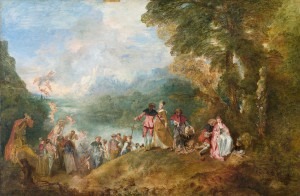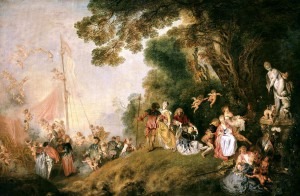
Watteau: L’Embarquement pour Cythère (1717)
Jean-Antoine Watteau (1684 –1721), who died when he was only 36, pushed the French Baroque into the French Rococo. He broke the formal and severe style of the Baroque by painting attractive scenes that were more naturalistic, while at the same time wildly imaginative. Watteau’s invention of the fêtes galantes genre, which showed charming bucolic scenes with a hint of theatricality, can be seen in L’Embarquement pour Cythère. This was his first picture for the Academy des Beaux Arts and shows a group of lovers departing (rather than arriving as the title implies) from the island of Cythera. Cythera was the birthplace of Venus and the lovers departing from her island is taken as emblematic of the transience of love. The lovers leave Venus’ island, paired up, with one woman glancing back fondly at Venus’ grove. Watteau painted another version in 1719, making elements such as the statue of Venus on the right side of the painting more obvious, with yet more active cupids. A boat now figures in the background.

Watteau: L’Embarquement pour Cythère (1719)
Debussy: L’isle joyeuse (Paul Crossley, piano)
Written first as a work for piano, L’isle joyeuse was later orchestrated with Debussy’s permission by Bernardino Molinari, an Italian conductor. As an orchestral work, it sounds much more sinuous and sensuous than the piano original – the listener is no longer a character but sees everyone. The woodwinds chatter and slither, the brass add cheerful top notes, the harp contributes a brittle sound, and a sheen seems to have been dropped over the entire picture.
Debussy: L’isle joyeuse (Lyon National Orchetra; Jun Markl, cond.)
Although Debussy claimed that L’isle joyeuse was pure imagination (he also claimed he didn’t write impressionist music), the connection between the art and the music, particularly in its capture of Watteau’s blend of happiness and poignancy, is a perfect pairing of love on a summer’s day.
